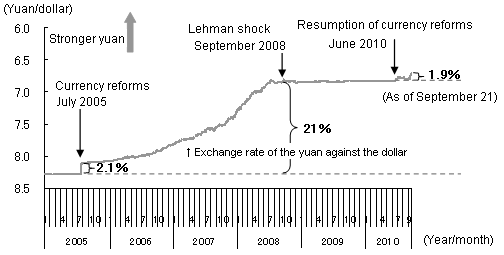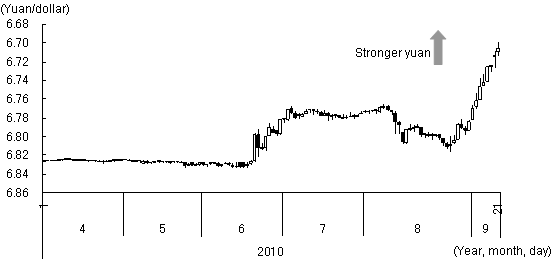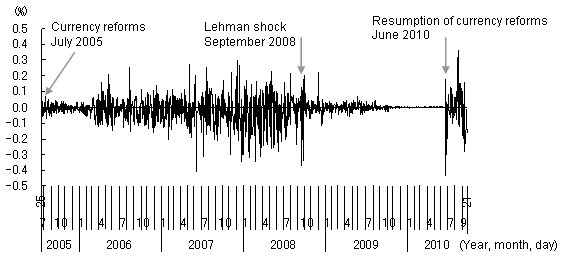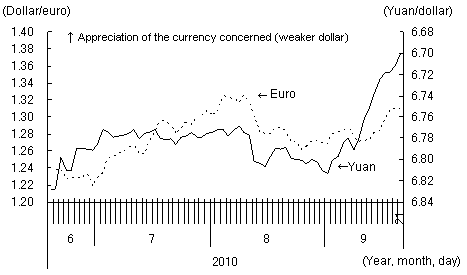With the aim of increasing the independence of its monetary policy and easing trade tensions with the United States, China has been addressing the issue of currency reform. As part of this, the People's Bank of China (the central bank) announced on June 19, 2010 that it would further increase the flexibility of the exchange rate of the yuan, or RMB. The following Monday, June 21, it terminated the effective dollar peg system that had been in place since the collapse of Lehman Brothers in September 2008, to resume the revaluation of the yuan (Figure 1). In doing so, China returned to the managed floating rate system that was introduced with the reforms in July 2005 and in place for approximately three years. Three months after the currency reforms were resumed, how the new system operates has now become more and more evident.
| Figure 1 : Changes in the RMB-Dollar Exchange Rate (Daily) | |
 | |
| (Source) | The State Administration of Foreign Exchange of China |
A managed floating rate system based on the BBC system
Commenting on the managed floating rate system China introduced in July 2005, Professor Yu Yongding, a then member of the Monetary Policy Committee of the People's Bank of China, explained that it was equivalent to the BBC, or "band (band of fluctuation), basket (basket of currencies) and crawling (fine-tuning of the exchange rate in either an upward or a downward direction)," system that appears in textbooks on international finance ("The Historic Decision to Reform the Yuan Exchange Rate Regime," Jinrong Shibao, July 23, 2005). Initially, the daily band of fluctuation was limited to 0.3% above and below the daily fixing rate (middle rate) announced by the authorities, but this was subsequently expanded to 0.5%. With respect to the basket of currencies, although the weights of constituent currencies were not announced, the dollar is believed to have been assigned the heaviest weighting, given the lack of synchronization between the yuan and major currencies other than the dollar. In addition, with respect to the speed of crawling, the government made decisions on a discretionary basis in light of the economic conditions, and the yuan was allowed to rise by approximately 21% against the dollar in total (6% annually) in the three years between the introduction of the managed floating rate system and the Lehman Brothers bankruptcy.
With the resumption of currency reforms in June 2010, China returned to the managed floating rate system based on BBC.
First, although the daily band of fluctuation remains at 0.5% above and below the fixing rate, the actual range of fluctuation has become larger than before (Figure 2). Not only the intra-day fluctuation, but the fluctuation of the daily fixing rate itself has also become larger (Figure 3). The standard deviation of the rates of change of the fixing rate from the previous day, which indicates the volatility of the exchange rate of the yuan, reached 0.12% for the three months since June 21, 2010, and this is not only larger than the volatility for the roughly two years since September 2008 when the dollar peg system was effectively adopted, but also the volatility for approximately three years (0.09%) since July 2005 when the managed floating rate system was implemented.
| Figure 2 : RMB-Dollar Exchange Rate Showing More Flexibility —Comparison before and after the resumption of revaluation— | |
 | |
| (Source) | Bloomberg |
| Figure 3 : Increasing Volatility of the RMB Exchange Rage —Day-on-day rate of change of the daily fixing rate— | |
 | |
| (Source) | The State Administration of Foreign Exchange of China |
Also, the degree of synchronization between the exchange rate of the yuan and major currencies other than the dollar, particularly the euro, has become stronger (Figure 4). This appears to reflect the increasing weight of other major currencies like the euro, in the basket of reference currencies at the expense of the weighting of the dollar.
| Figure 4 : The Yuan Showing Stronger Synchronization with the Euro | |
 | |
| (Note) | For the euro, data of the previous days are used due to the time difference. |
| (Source) | Bloomberg and the State Administration of Foreign Exchange of China |
In addition, although the RMB-dollar exchange rate (the daily fixing rate) is rising in response to the crawling component, the rate of increase remains modest at just 1.9% for the three months since the revaluation was resumed. This is clearly not a reflection of market demand and supply, but a result of the market intervention by the authorities.
Exchange rate policy remains focused on "management" rather than "floating"
The ongoing currency reforms serve the dual purpose of increasing the independence of Chinese monetary policy at home and easing trade tension with the United States abroad. However, while the RMB exchange rate has become more flexible, the reforms have yet to display their anticipated effects, as the operation of the foreign exchange policy remains focused on "management" rather than "floating." In particular, President Barack Obama, Treasury Secretary Timothy Geithner, and U.S. Congress, with an eye to the midterm elections in November 2010, are all criticizing the insufficient rise in the RMB exchange rate, and trade tensions between the United States and China are escalating, rather than subsiding.
To respond to the criticism, Chinese authorities would need to ease up on their "management" by cutting back on intervention and leave the exchange rate to the market to the maximum extent possible. However, signs of them doing so have yet to be seen and a significant rise in the RMB exchange rate is unlikely in the foreseeable future.


